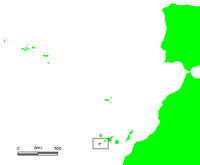
Photo from wikipedia
Abstract Barren Island, situated in the Andaman Sea, is the northernmost active volcano of the Sunda arc. The oldest known eruption of the volcano was during the period 1787–1832. After… Click to show full abstract
Abstract Barren Island, situated in the Andaman Sea, is the northernmost active volcano of the Sunda arc. The oldest known eruption of the volcano was during the period 1787–1832. After about 150 years of quiescence, volcanic activity resumed in 1991 and continues since then. The magmatic plumbing system of this volcano is largely unknown due to lack of geophysical experiments owing to its remote location. We report, for the first-time, time-series surface deformation measurements of Barren Island volcano from interferometric synthetic aperture radar (InSAR) during epochs 2007–2011 and 2015–2017. Line-of-Sight (LOS) deformation of −50 mm/yr during 2007–2011 at the cinder cone is interpreted as the co-eruptive pressure changes associated with the 2008–2010 eruptions. Bayesian inversion suggests a shallow magma reservoir at a depth of 578−100+300 m below the summit. The depth of the magma reservoir is shallower than that of other volcanoes of the Sunda arc, probably due to the extensional stress regime imposed by the oblique subduction. Based on the present studies and previous works, we propose a plausible source model for Barren Island volcano. We also discuss potential biases in the present source parameter estimation due to the lack of high quality InSAR data from both ascending and descending directions. Significant deformation (−15 to −150 mm/yr) observed along the lava delta of Barren Island volcano for both the epochs are interpreted as post-emplacement subsidence of the lava flow. Further, we characterise the lava flow including volcanic deposits by mapping its spatial extent and elevation changes during 1979–2000 and 2000–2017 periods using geodetic measurements.
Journal Title: Journal of Volcanology and Geothermal Research
Year Published: 2020
Link to full text (if available)
Share on Social Media: Sign Up to like & get
recommendations!